Fundamental cooperation. Joint Institute for Nuclear Research turns 65
Interview, 29 March 2021
A popular scientific electronic magazine “Scientific Russia” has published a series of interviews with the heads of the Joint Institute for the 65th anniversary of JINR. An interview with JINR Scientific Leader RAS Academician Victor Matveev was the first. Read also an interview with JINR Vice-Director RAS Corresponding Member Vladimir Kekelidze published on 25 March and with JINR Director RAS Academician Grigory Trubnikov published on 27 March.
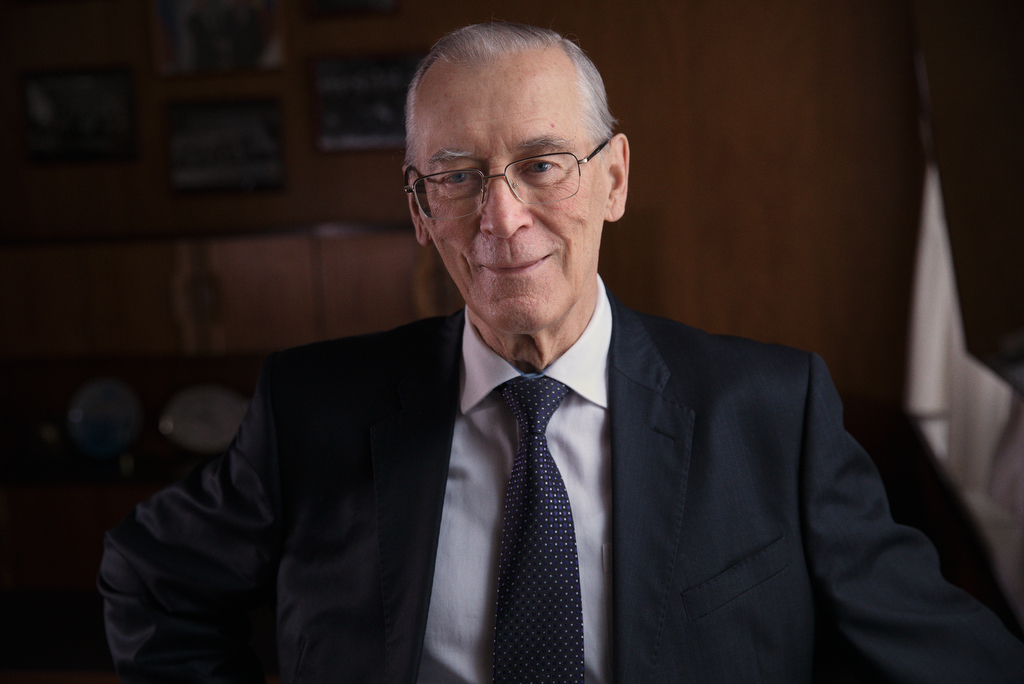 Victor A. Matveev, Scientific Leader of Joint Institute for Nuclear Research, RAS Academician. Photo by Nikolay Malakhin
Victor A. Matveev, Scientific Leader of Joint Institute for Nuclear Research, RAS Academician. Photo by Nikolay Malakhin
March 2021 marks the 65th anniversary of the Joint Institute for Nuclear Research in Dubna. On the northern outskirts of the Moscow Region, scientists from 18 Member States study fundamental issues. These are Azerbaijan, Armenia, Belarus, Bulgaria, Cuba, the Czech Republic, DPRK, Georgia, Kazakhstan, Mongolia, Moldova, Poland, Romania, Russia, Slovakia, Ukraine, Uzbekistan, and Vietnam.
“In 1965, you came to the Institute as an intern. What were the tasks set for employees of the international organization back then?”
“Nikolay N. Bogoliubov, who later became my teacher, understood that we had to look for new young people from different cities of the Soviet Union to move forward and develop science (since 1965, N. N. Bogoliubov was JINR Director, ed. note). He agreed with Head of the department, Academician V. A. Foc at Leningrad University on sending a group of young theorists to the Institute for an internship. I joined that group. We spent several months at JINR. I realised that I would really like to get into this largest scientific centre. We were research interns. Back then it was very prestigious.
At that time, everyone was waiting for new discoveries. It was due to the fact that a lot of data had accumulated on elementary, strongly interacting particles, namely those that appear during collisions of accelerated particles. It was necessary to find some completely new approaches to the description of the systematics of particles, understand what determines the fundamental interaction between them. Scientists collected a large number of facts. However, there was no coherent theory, only models and guesses. It was necessary to go deeper into the theory of elementary particles in order to understand where the roots are, which make it possible to build a coherent theory that would explain a large number of particles being born and the peculiarities of their interactions.
Then it became clear that experimental research at high-energy accelerators brought new knowledge. But not necessarily only at accelerators. They began to bring really new data on the deep structure of matter in the fields of astrophysics. One of the outstanding scientists, Academician M. A. Markov said one thing. It is important not to tune into research programmes that would be determined by certain energy intervals, but to look for key problems that would require some new approaches and tools for their understanding or discovery.
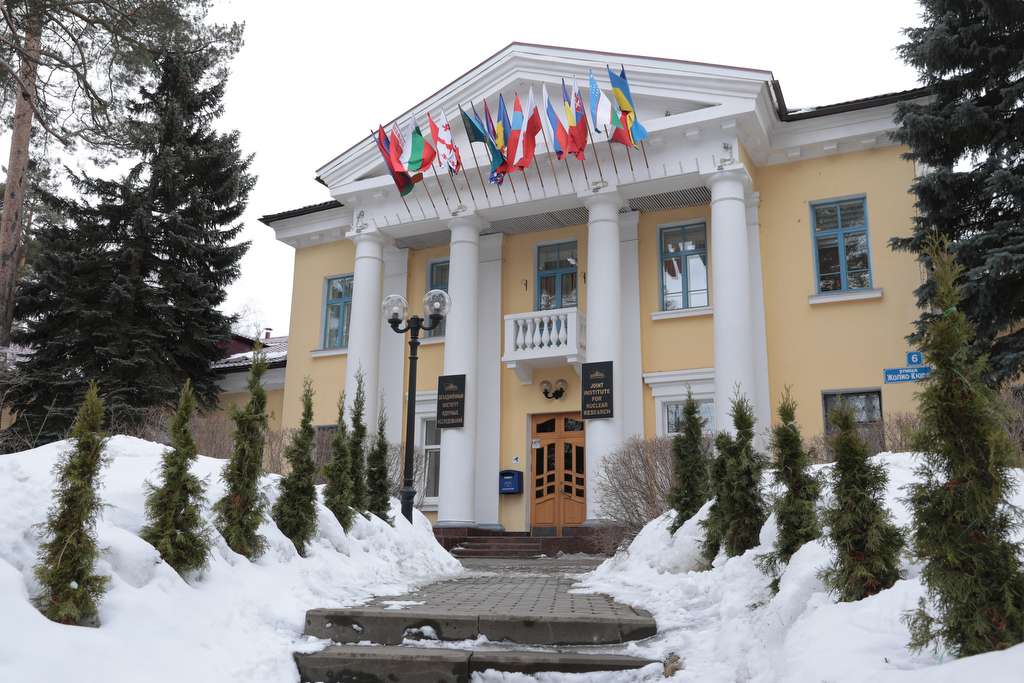 Administrative building of Joint Institute for Nuclear Research. Flags of eighteen Member States are above. Photo by Nikolay Malakhin
Administrative building of Joint Institute for Nuclear Research. Flags of eighteen Member States are above. Photo by Nikolay Malakhin
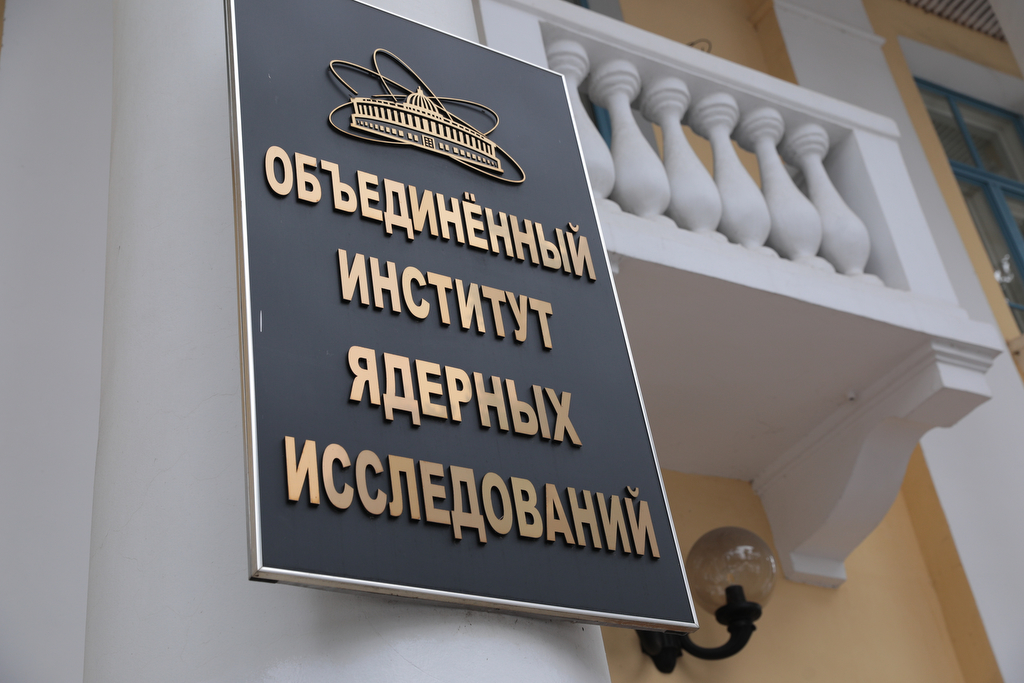 Entrance to administrative building of Joint Institute for Nuclear Research. Building is located on Joliot-Curie street. Photo by Nikolay Malakhin
Entrance to administrative building of Joint Institute for Nuclear Research. Building is located on Joliot-Curie street. Photo by Nikolay Malakhin
And I came to JINR at a time when these ideas were around us, and there was a great demand for theorists. I was finishing my studies reading magazines. I was interested in it. When I was seconded and hired, they were glad to hear from me, “I’m ready to do it.” I believed that something new, unique, and beautiful was emerging in theory. I was ready to be told, “Do it.” And I was lucky. I came to the Institute when hypotheses were born here about what helps to build a theory of strong interactions. There was a lack of awareness of the presence of an extremely new charge. And it was my first job. Nikolai N. Bogoliubov gave me and my colleagues this idea”.
“For 65 years, since the opening of the Institute until now, 18 elements have been discovered. 10 of them have been discovered at the Joint Institute for Nuclear Research. What is the advantage of Dubna? Why were these discoveries made here?”
“Even before the JINR creation, within the Kurchatov Institute, Georgy N. Flerov was charged with the idea that for fundamental physics it is important to understand the foundation on which the entire observable world is based. Among other things there are nuclei that have not yet been discovered, but should play an important role in the overall picture of physical phenomena. Moreover, the nuclei, especially heavy ones, are developed in special conditions. They are the products of star burning. Therefore, knowledge about new superheavy elements, among other things, requires an understanding of the processes that take place in extreme conditions in space.
Georgy N. Flerov came to the Institute with his closest associates, charged with the idea that JINR would solve this problem not as a by-product, but as one of the general ideas.
In addition, in the ’60s, theorists in the USSR, the USA, and European countries were toying with the idea that the genus of superheavy elements does not end. And everyone started looking for these elements. This ambitious task was set as the main one in the Laboratory of Nuclear Reactions, which was created by Academician Flerov.
Scientists opened a number of new elements, but there was a stop. It was clear that scientists needed something new, a new technique. Then it was possible to concentrate theoretical ideas and experience. The discovery of superheavy elements was successful as well. On 15 December 2015, the International Union of Pure and Applied Chemistry recognised Dubna as the author of the discovery of five more new elements. These are 114 (flerovium), 115 (moscovium), 116 (livermorium), 117 (tennessine), and 118 (oganesson). In the history of science, there are only two cases when the names of living scientists were used to name new elements (Oganesson is named after Academician Yuri Ts. Oganessian, Scientific Leader of the Flerov Laboratory of Nuclear Reactions. The first case when an element of the Periodic Table was named after a scientist during his lifetime happened in 1997. Back then they decided to name element 106 in honour of a physicist Glenn Seaborg, ed. note).
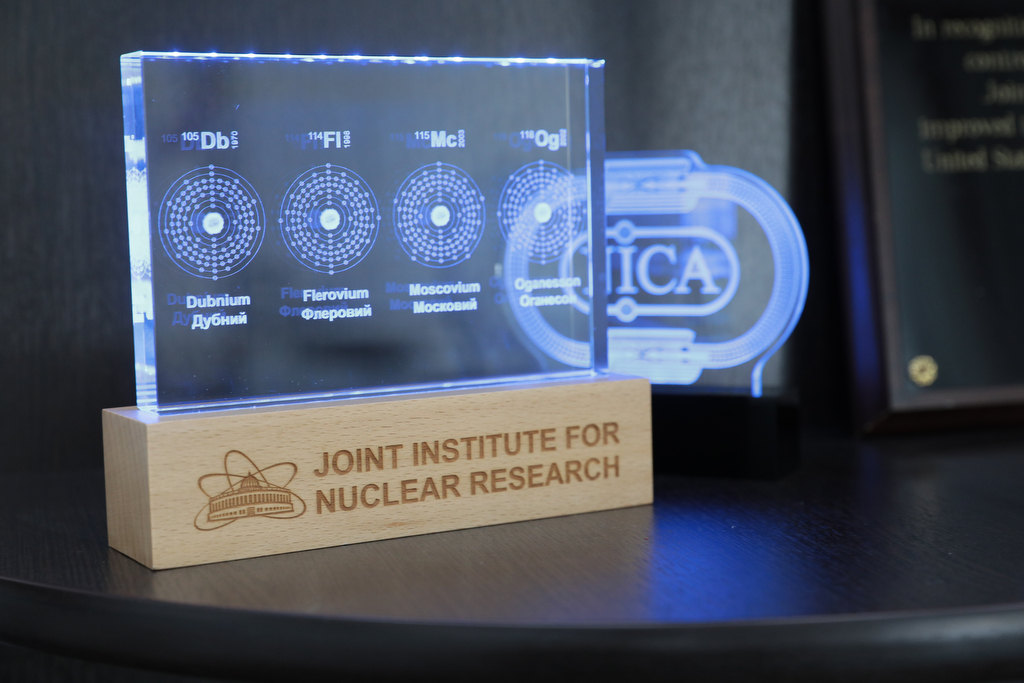 Souvenir products depicting superheavy elements, which names are associated with JINR, namely 105 (Dubna) and 115 (Moscow Region, where the Institute is located), 114 (Flerov Laboratory of Nuclear Reactions), and 118 (Scientific Leader of the Laboratory of Nuclear Reactions Yuri Ts. Oganessian). Photo by Nikolay Malakhin
Souvenir products depicting superheavy elements, which names are associated with JINR, namely 105 (Dubna) and 115 (Moscow Region, where the Institute is located), 114 (Flerov Laboratory of Nuclear Reactions), and 118 (Scientific Leader of the Laboratory of Nuclear Reactions Yuri Ts. Oganessian). Photo by Nikolay Malakhin
People in Dubna understand that it is necessary to move on. Now the question is whether the framework of the Periodic Table has been finally determined? Are there other elements? What are the limits of the classification of superheavy elements, where are their boundaries in the world?”
“The NICA Project is one of the new tools that is being prepared in Dubna. What hopes do scientists pin on it? To what extent can it expand the known picture?”
“The complex of all the knowledge about fundamental interactions, elementary particles led to a theory, which is known as the “Standard Model of elementary particles”. Although it is simply called “Standard Model”, I believe that this is the highest intellectual achievement of mankind now.
There is one element that is not fully understood, because it is a component of the theory that is associated with the concept of “strong nuclear interactions”. Due to the strength of these interactions, scientists cannot study them theoretically. Special methods of description are required, that’s why scientists need to find much in direct experiment.
Physicists have a certain picture of the formation of the world at the Big Bang. It was based on quark-gluon matter, which consisted of the most fundamental, as we now say, “structureless” particles. What were the properties of the original bunch of matter, from which the entire universe was formed then?
By the way, we all consist of nuclei, chemical elements. And inside each nucleus there are protons and neutrons. Every proton and neutron is made up of quarks. These are the same quarks that were formed 14 billion years ago at the Big Bang. Not others, but the same ones. Nuclei are born and die. And what comes to elementary particles, they are born and stay in us. I would like to understand what properties that matter possessed, from which the entire universe was then formed.
So far, it is theoretically impossible to describe it, and direct experiments are needed. NICA is the very tool that will help to create bunches, even the smallest, of this quark-gluon matter in the laboratory”.
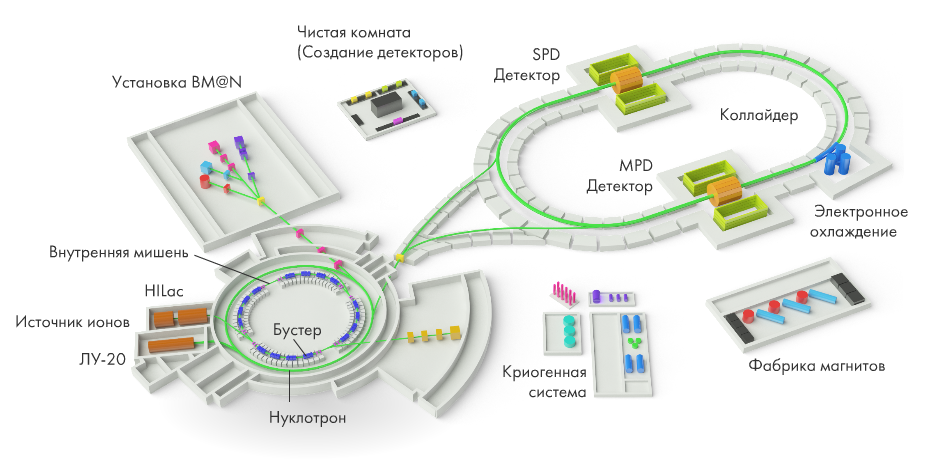 NICA Complex, Nuclotron based Ion Collider fAcility). Image from NICA Project website
NICA Complex, Nuclotron based Ion Collider fAcility). Image from NICA Project website
“At what stage is the project now?”
“In December last year, we managed to launch the Booster accelerator, in which heavy nuclei are accelerated. Then they are injected into another accelerator, and they accumulate there. And it demonstrated very good parameters. At the end of the year, we have to carry out the first physical experiment. The beams accelerated in the Booster will be injected into the Nuclotron. This machine is already there. It is upgraded and ready to accept, accelerate and accumulate heavy nuclei. We will take this step at the end of this year.
And next year, the full collider will be completed, and the first physical experiment will take place. Everything is going really fast. That’s why it’s nice that young people who are around realise that the Institute is a place where you can deal with the latest technologies, the latest trends”.
“How do you work with young people? Where do you attract new staff from and, since the Joint institute is located in Dubna, what about people from other countries?”
“We are glad that we have a lot of young people, but we can’t say that we have no problems. There is a struggle for a young talented force in the world right now.
We have departments as in other institutes. There is even its own university in Dubna, which helps to train its own engineering and technical staff. At the initiative of Yuri Ts. Oganessian, who understands that a talented engineer can be more important than a theoretical physicist today, we together with Bauman Technical University have created a Higher Engineering School. There is a special course for which students enrol. For the first years they listen to lectures at Bauman University, then they come here and work at our facilities.
Now our partners see the level of work. They try to guide not experienced, but young people. To gain experience here, learn things that will be difficult to learn at home. Therefore, we have many offers to enrol such young people from abroad.
Nowadays, young people are very ambitious, they want to realise themselves. Therefore, first of all, we must show young people that we can help to realise their potential. Young people can find something that they immediately want to master, and it is necessary to give them such an opportunity. On the other hand, modern people need a full life. People need conditions to engage in sports, read literature, so that there is a cultural environment. Therefore, we are proud that outstanding artists and musicians come to us willingly. Such a large international centre as ours should be a universal one, including being a cultural centre. It requires a lot of attention from the management, but we do it because it is our necessity”.
“In the 2010s, when you headed the Institute, the escalation of the foreign policy situation started. And this process continues to this day. Does the foreign policy situation affect joint scientific developments? “
“It can’t help but influence. Russia is the location country of the Institute, as we say. There is already an understanding that megaprojects, which can serve as drivers of overall development, will play the main roles in the development of fundamental science, followed by innovations. Now NICA projects and the Superheavy Elements Factory can serve as such drivers. We had to prove that we were not creating this for ourselves, but implementing projects that would be in demand by world science. That they fit a range of priorities that the world evaluates. To do this, it is necessary to approach the organization of the Institute’s work in such a way as to achieve maximum transparency, efficiency, and modern organization of work. And that means earning international credibility.
The International Scientific Council is the main body that devises the strategy and consolidates what we are working on. I can proudly say that our Scientific Council, and this is 50 people, are the brightest minds of world science. There are people who consider it an honor to give their consent to work. These are people who have world-famous scientific achievements, people who have led major projects. They are all willing to work for us.
This leads to the fact that the sanctions are not effective against us, because we are not an organization of one state. The main thing that we have to do is to convince everyone in the world that we really work as an international organization. That all of our goals are connected with getting results for all humanity. We need everything to be transparent, so that we are open to any criticism or any suggestions. A high international prestige is one of the greatest wealth of our Institute now.
Our most important facilities, namely the NICA Complex, the Superheavy Elements Factory and the Baikal Telescope are already entering the landscape of fundamental physics in the world. We are elements of a global strategy”.
“About ten organizations from different countries took part in the creation of the Baikal Telescope. What role did the Joint Institute for Nuclear Research play in the creation of the telescope?”
“The very idea of such large-scale particle detectors was born in Russia and largely in Dubna. At about the same time when the Institute was organized. The idea was proposed in order to understand what role the neutrino plays and how it can be used.
Neutrino is a very weakly interacting particle. Theorists say that it can penetrate hundreds of thousands of globes and will not get stuck anywhere. The idea was developing. It was necessary to work out the technology, the theory of decoding the data that causes a neutrino flying through space. At the same time, the task was to find ultrahigh energy neutrinos, which can be a fruit of exclusively extreme phenomena in space. It is extremely important to find out the conditions and causes of the appearance of ultrahigh energy neutrinos in order to understand the fate of the Universe and our star world in general.
It took Dubna to carry out the first experiments, use technological developments to create the first real large detector. Only at the Institute, scientists managed to set a task of the right scale, include young people who could work out all the elements. Therefore, starting from 2013, Dubna began to implement this programme as one of the most important programmes of the international Institute.
Now, 8 clusters are submerged to the bottom of Lake Baikal. They provide real-time data to coastal centres, and the first data is already fantastic. There are already a dozen decoded events caused by neutrinos with energies that are higher than a hundred teraelectronvolts. This means that there are objects in space, in which such extreme processes occur that modern theory cannot yet describe. It is a big task to understand these processes and what is happening there, what new interactions are being implemented in space. It used to be a figment of the imagination, a fantasy, but now it work”.
“Was this project possible by the efforts of only Russian institutions?”
“Experience suggests that objects of this scale require international cooperation. We need a concentration of intelligence here. We need to work out and evaluate everything so that knowledge really is knowledge. Now, international cooperation is the highest assessment, it allows you to gain knowledge of such a high level. A completely new branch of knowledge, namely neutrino astronomy, is being born now. We know a lot about the universe. We have received information from optical and X-ray telescopes. And now neutrino ones. Neutrinos are able to bring information from long distances.
When we tell students or schoolchildren about this, they ask, “What can we expect from a neutrino if it interacts so weakly?” It weakly interacts with thinner matter. For example, you and I are thinner matter. But in a star that is under the pressure of gravitational forces, neutrinos play a big role.
Loot at the starry sky at night. You see the “stellar stoves”, where the neutrino does the main job, regulates all the star burning. As long as the star is not too tightly squeezed by gravity, the neutrino is able to carry energy from its very interior. This does not allow the star to overheat. A star overheats when it becomes so tightly compressed that even a neutrino cannot escape and gets stuck. Then the star overheats and explodes. The burning process, the processes of the birth of new elements stop.
Nature uses everything. Neutrinos are one of the main elements of the technology of stellar matter burning. It is important to understand what knowledge about these extreme processes it will bring from space”.
“In 2020, the pandemic began. How did this year and restrictions affect the Institute’s developments?”
“It was a difficult trial, and it continues. We have analysed everything from the very beginning and determined that we cannot stop the Institute. Programmes require constant work. We took all possible measures to minimise the danger to the staff. We created conditions for some employees to be able to work productively at a distance. We cannot stop work when the NICA complex is being built. But we have to control that the builders comply with all the necessary security measures. The pandemic led to certain delays, namely in the supply of materials, the production of a number of equipment.
But the coronavirus showed us importance of the team’s passion. The atmosphere, when everyone is moving along the planned path and waiting for the result, allowed minimising losses that inevitably arise in such situations. We are also responsible to our Member States. Therefore we must create such conditions that all our partners feel like at home when they are in Dubna. And the main milestones that we outlined have been successfully passed.
We really lack communication. Representatives of 18 countries are on the screens at the Finance Committee. Only a few people are here at the Institute. But even now there remains trust, without which there is no faith in the result.
It is highly important that a young elected Director Grigory V. Trubnikov is now at the Institute. I am proud that I saw in advance that this young man, an Academician, will continue the path of development of the Institute sticking to the principles of continuity. And maybe at a higher rate”.